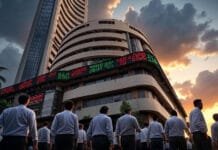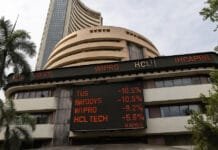Tokyo | Seoul | Sydney | Washington D.C. — In a seismic shift across the global economy, Asian stock markets nosedived on Tuesday as former U.S. President Donald Trump’s announcement of a 104% tariff on Chinese imports triggered panic selling and investor alarm. With hours left before the policy takes effect at midnight, global markets are bracing for an all-out economic storm.
Asian Markets Plunge
From Tokyo to Sydney, the financial contagion spread fast:
- Nikkei 225 (Japan): Closed down 3.5%, erasing nearly all gains made in 2025.
- KOSPI (South Korea): Fell over 2.8%, amid fears of export disruptions.
- ASX 200 (Australia): Dropped 1.9% as commodity-dependent markets reeled.
- Hang Seng (Hong Kong): Lost more than 3.2%, signaling deepening tensions in the region.
Wall Street, too, has not been spared. The S&P 500 has fallen nearly 10% from its February peak, with over $5.8 trillion in market value erased in recent weeks.
A Return to Trade War Tensions
Trump’s tariff policy—hailed by his supporters as a hardline stance to protect American interests—is being described by critics as a dangerous game of economic brinkmanship. The tariffs, primarily targeting tech and heavy machinery imports from China, revive the spirit of the 2018–19 trade war that rattled global growth.
The U.S. Trade Representative’s office confirmed the tariff will be applied universally with no exemptions. President Trump called it a “necessary correction” to “decades of unfair trade practices.”
Beijing Prepares to Strike Back
China has not stayed silent. A spokesperson for China’s Ministry of Commerce said retaliatory measures are “inevitable,” and may include targeted tariffs on U.S. agricultural and tech exports. The move is expected to affect everything from semiconductors to soybeans.
“Markets are pricing in a recession risk now,” said a Tokyo-based analyst. “These tariffs could push global GDP down by at least 1.2% if retaliation follows.”
U.S. Investors Sound the Alarm
The Dow Jones Industrial Average, after opening strong with a 1,460-point surge, reversed gains to close 320 points lower. The Nasdaq Composite also slumped 2.1%, reflecting heavy losses in tech giants who rely on Chinese supply chains.
Analysts warn of lasting damage if the standoff persists.
“This is not just a tariff; it’s a shockwave to the global economy,” said Dr. Emily Granger, an economist at NYU Stern. “Companies are recalibrating supply chains, investors are pulling out of risk markets, and currencies are beginning to fluctuate wildly.”
What Happens Next?
The countdown is ticking. If no diplomatic breakthrough occurs, midnight will mark the beginning of a new trade war era. Trump’s tariffs could redefine U.S.-China relations and alter the course of the 2025 global recovery.
For now, all eyes are on Beijing—and Wall Street.















